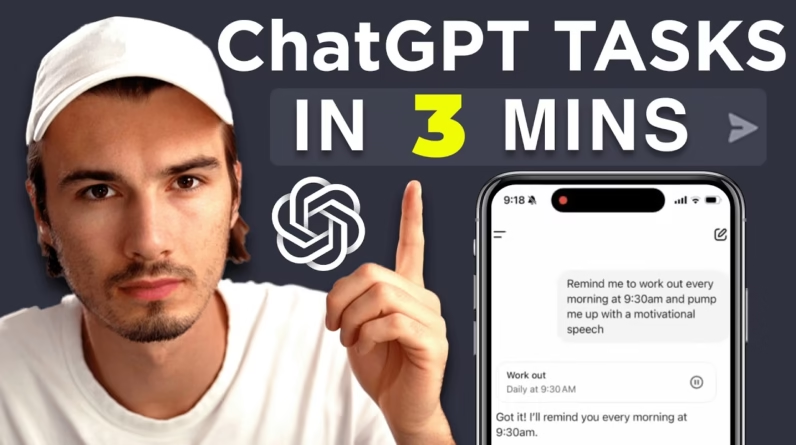
Exciting new advancements in AI have emerged, transforming the way you manage tasks and interact with technology. From innovative features in ChatGPT to the impressive capabilities of the new Sky-T1 model, these developments promise to enhance your productivity and streamline your daily routines. Additionally, tools like the AI Clothing Try-On and personalized podcast summaries offer creative and tailored experiences, making your everyday activities even more engaging.
The latest AI tools provide a range of functionalities designed to enrich your workflow and personal life. As you explore these new features, you’ll find opportunities to improve your task management and creativity while enjoying a more customized interaction with AI. This article will highlight these exciting innovations and the potential they hold for expanding how you leverage technology in your daily life.
Table of Contents
Emergence of New AI Features
Overview of Recent AI Developments
Hey there! Have you noticed the buzz in the tech world lately about new AI innovations? There are some exciting developments on the horizon, particularly with tools designed to enhance productivity and creativity. From recently introduced features in ChatGPT that aid in task management to the unveiling of powerful new models like Sky-T1 and video generation technologies, the AI landscape is evolving rapidly. These advancements are not just about making existing tools better, but they’re also paving the way for entirely new experiences.
Impact on Task Management Systems
The introduction of new AI capabilities, particularly in the realm of task management, is something you might find incredibly beneficial. For instance, ChatGPT’s new task management features have been designed to streamline how you organize and prioritize tasks. It allows you to interact with the AI to set reminders, make to-do lists, and even get motivational boosts. As these systems become more integrated into everyday tools, they’re poised to reshape how you manage your time and responsibilities, making it easier to balance work and personal life.
Predictions for Future Growth
Looking ahead, it’s hard not to feel excited about the potential growth of AI features. We can expect continuous integration of AI into more aspects of daily life, especially as companies focus on improving user experience and functionality. As AI models become more sophisticated, you’ll likely see them adapting to your specific needs, further enhancing productivity and creativity across various domains. So, keep an eye out—the future is definitely bright!
ChatGPT Tasks Enhancements
Introduction of New Task Management Features
If you’re a fan of ChatGPT, you might have already explored its latest features aimed at task management. Think of it as your personal assistant that helps you keep track of what you need to accomplish. You can organize tasks into categories, set priorities, and even receive feedback on your progress. The goal is to make managing your day-to-day tasks a lot less daunting and a lot more enjoyable.
User Experience Improvements
With these new enhancements, user experience has significantly improved. The interface has become more intuitive, allowing you to interact with the model in a more fluid manner. It’s almost like having a conversation with a friend who is genuinely interested in helping you get things done! The responsiveness and accuracy of task-related queries have also seen upgrades, which means you can rely on the AI more than ever to assist you in your productivity journey.
Criticism and Limitations of ChatGPT Tasks
However, no new feature is without its critics. Some users have raised concerns about the utility of these task management features, questioning whether they offer more than traditional methods of task organization. While it’s true that the AI may not replace comprehensive project management tools, it certainly has its place as a supplement. It’s important to remember that while AI can assist, it may not always perfectly understand your unique needs or context, so your input remains crucial.
The Sky-T1 Model
Key Characteristics of Sky-T1
Sky-T1 is one of the latest releases in the realm of large language models (LLMs). What’s remarkable about this model is that it can be trained at a cost of under $450, making it accessible for individual developers and smaller companies. It’s designed to excel in reasoning tasks and has features optimized for diverse applications, allowing you to harness its power without breaking the bank.
Cost Benefits and Affordability
This affordability is a game-changer, especially if you’re interested in leveraging sophisticated AI technologies in your projects. For personal use, educational purposes, or even for small business applications, Sky-T1 makes it feasible to access advanced AI capabilities without needing extensive resources. Imagine using a powerful AI model for creative writing, data analysis, or automating repetitive tasks—all at a fraction of the cost!
Comparison with Existing Models
When you compare Sky-T1 to existing models, it stands out not just for its price but also for its performance in reasoning tasks. While some top-tier models remain industry standards, Sky-T1 presents itself as a compelling alternative that you can turn to for innovative applications. As it evolves and improves, it’s likely to attract even more attention in the AI community.

Innovative Prompting Framework
Dan Mac’s Goal-Based Prompting
If you’ve dabbled in AI prompting, you’ve probably noticed that not all prompts yield the same results. A notable development is Dan Mac’s goal-based prompting framework. This approach encourages you to think strategically about what you want to achieve with your prompts instead of feeding the AI mere instructions. By clarifying your end goal, the AI can navigate its response more effectively, giving you more valuable and tailored outputs.
Benefits of Effective Prompting Strategies
Using goal-based strategies can significantly enhance your interactions with AI. You’re not only improving the quality of the results you receive but also empowering the AI to engage in more complex and thoughtful reasoning. Imagine being able to have more nuanced discussions or collaboratively work on creative projects—it all starts with how you frame your requests!
Comparison to Traditional Instructional Methods
Traditional methods often rely on explicitly detailed instructions, which can limit the AI’s potential. In contrast, goal-based prompting encourages a dialogue that can adapt to evolving needs. Rather than just asking for a list or a straightforward answer, you can explore broader solutions that take the conversation to more exciting and unexpected directions. This shift can create a more enriched user experience that feels collaborative.
Minimax-01 Video Generation Model
Introduction to Minimax-01 Capabilities
Minimax-01 has recently emerged as a formidable player in video generation, capable of delivering content that feels incredibly lifelike and engaging. With its advanced machine learning algorithms, this model can generate meaningful and contextually rich videos, opening up new possibilities for content creators like yourself. Whether for marketing, education, or entertainment, the capabilities of Minimax-01 are quite mesmerizing!
Importance of Context Retention
One of the most impressive features of Minimax-01 is its remarkable context retention. This model can remember up to four million tokens in a single setup, which is a leap ahead of others like ChatGPT, which typically maxes out much lower. With such a vast memory, you can create longer narratives or complex scenarios without losing continuity, something especially valuable for filmmakers and storytellers.
Benchmark Performance Overview
When evaluated against its peers, Minimax-01 has shown superior performance, achieving perfect scores in context retrieval benchmarks. This means that when you’re using it, you’ll not only get high-quality outputs but also ones that make sense and maintain coherence throughout. For creative professionals and enthusiasts alike, this model promises to elevate video production to new heights.
Community Engagement in AI Development
Public Challenges and User Contributions
Community engagement plays a crucial role in enhancing AI development. Public challenges invite you to share your innovative use cases and prompt ideas, creating a vibrant space for collaboration. This not only fosters creativity but also allows various users to learn from one another, ultimately enriching the AI technologies we all rely on.
Promoting Collaborative Learning
By participating in these initiatives, you contribute to a shared pool of knowledge. Collaborative learning harnesses diverse perspectives, allowing ideas to flourish in ways that one person alone might not achieve. You’ll likely find that through collaboration, you not only learn more but also hone your skills in using these powerful tools.
Best Practices for Sharing Innovations
When sharing your ideas and innovations, consider documenting your approach, challenges faced, and solutions found. This will help others learn from your experiences, enhancing the community as a whole. Remember, sharing isn’t just about showcasing your work—it’s also about fostering an environment of mutual support and inspiration.
Testing and User Exploration
Plans for Ongoing Testing of New Models
With the rapid pace at which AI technology is advancing, there’s a strong emphasis on ongoing testing of new models. Both developers and users will engage in exploratory testing to better understand the capabilities and limitations of each model. As someone interested in AI, you’re invited to participate in these initiatives, which will help shape future developments.
User Involvement in Capability Exploration
Your involvement in exploring these capabilities is incredibly valuable. Real-world testing allows creators to gather feedback, which can inform adjustments and improvements. As you experiment with new AI tools, your insights can lead to enhancements that benefit the entire user community.
Feedback Mechanisms for Continuous Improvement
To ensure continuous improvement of AI tools, feedback mechanisms are crucial. Many platforms encourage you to share your suggestions, problems faced, and features you’d like to see in future iterations. Your feedback acts as a guide for developers seeking to enhance user experience, making your voice an essential part of the development process.
AI Clothing Try-On Tool: Lea
Features and Functionality of Lea
Lea, the innovative AI clothing try-on tool, is creating waves in the retail and fashion industry. It allows you to mix and match clothing items with AI-generated models, letting you visualize how different styles look without even trying them on. Imagine being able to experiment with outfits from the comfort of your home—how fun would that be?
Customization Options for Users
An exciting aspect of Lea is its customization options. You can upload your images and see how various clothing items suit your individual style. This personalized experience not only enhances shopping but also encourages creative exploration of your wardrobe, making it a valuable tool for anyone looking to update their look.
Potential Use Cases in Retail and Fashion
For retailers, integrating tools like Lea could revolutionize online shopping. By allowing customers to try on items virtually, companies can reduce return rates and improve customer satisfaction. As a user, this means a more informed shopping experience, enabling you to make choices that reflect your personal style more accurately.
Daily Listen by Google
Overview of Personalized Podcast Features
Have you heard about Google’s Daily Listen? It’s an exciting new feature that curates a personalized podcast experience for you, summarizing the latest news and content that matters to your interests. If you’re someone who loves staying informed but prefers auditory formats, this tool could fit perfectly into your daily routine.
Target Audience and User Experience
Daily Listen is designed for a wide audience, particularly those who enjoy podcasts and audiobooks as a way to absorb information. The user experience is seamless; you can engage with the content in a way that complements your lifestyle. Whether you’re commuting, exercising, or just relaxing at home, this feature makes it easy to keep up with the latest trends and news.
Accessibility and Availability for Users
Currently, Daily Listen is available for early access, but you might need a VPN if you’re in the US to start using it. As more users sign up and engage with the service, it’s likely that it will expand its availability, so stay tuned for more opportunities to explore this exciting tool!
Conclusion
Summary of Key Innovations
As we’ve explored, the emergence of new AI features promises to transform how you engage with technology in both fun and practical ways. From advanced task management systems in ChatGPT to innovative tools like Lea for clothing try-ons and Google’s Daily Listen for personalized auditory content, the landscape is rich with opportunities.
Implications for Future Task Management
These advancements suggest a future where task management becomes more intuitive and seamlessly integrated into our daily lives. With AI helping to organize your day-to-day activities, you might find yourself enjoying increased productivity and creativity in both your personal and professional pursuits.
Final Thoughts on AI Integration in Daily Life
In closing, the integration of AI into daily life is not just about convenience; it’s about enhancing the overall quality of experiences. By embracing these new technologies, you open doors to innovative ways of working, learning, and expressing yourself. So, keep exploring, stay curious, and enjoy the thrilling journey that AI has to offer!







